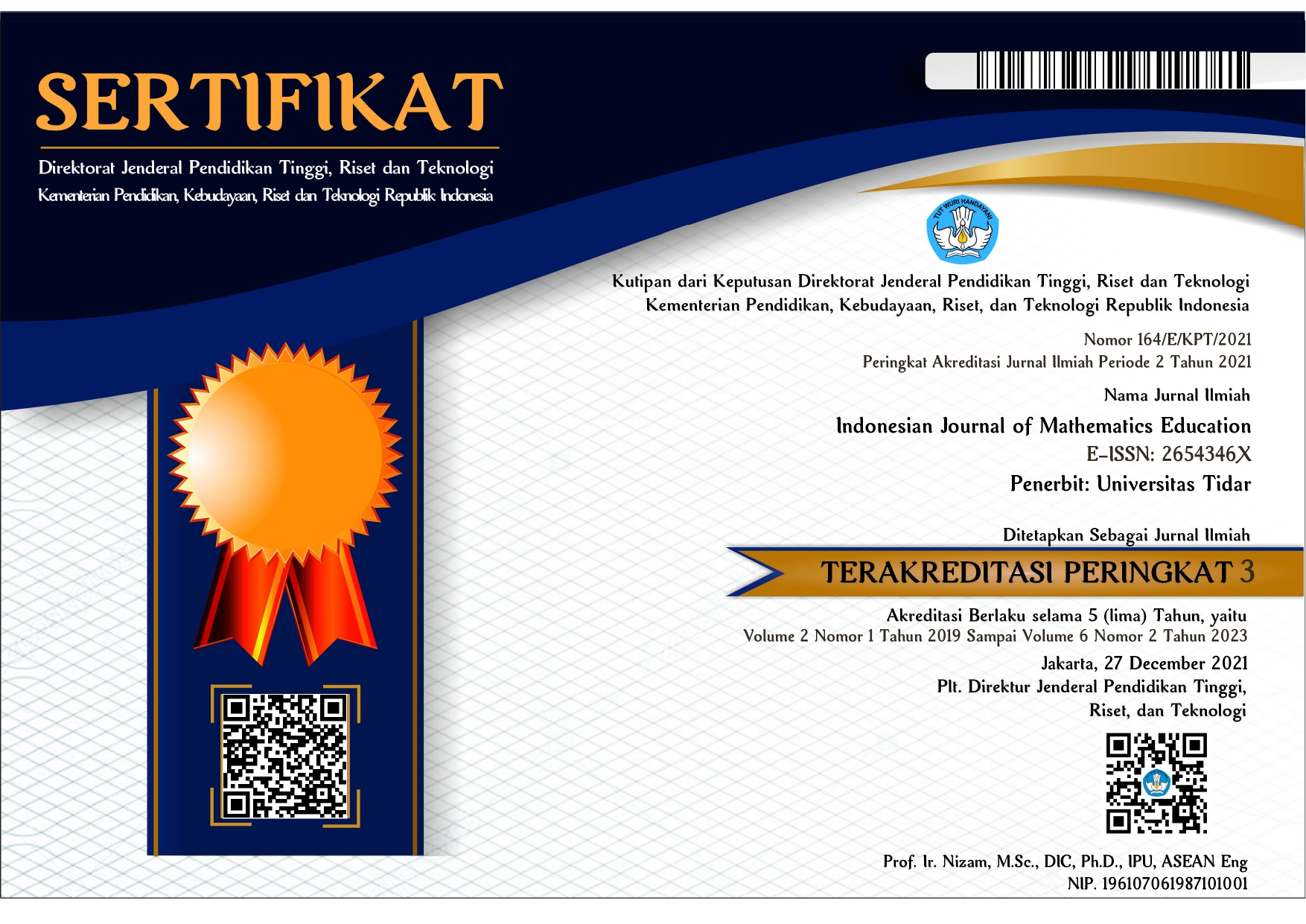Pedagogical Competence of Teachers and Online Engagement of Junior High School Students in the New Normal
Keywords:
Instructional materials, knowledge of subject matter, mathematics, new normal, online engagement, pedagogical competence, teaching style/techniquesAbstract
Most students are struggling in this new learning method and their engagement in learning math is deemed to be adversely affected due to limited interactions and accessibility in an online mode of learning, thereby affecting their motivation and achievement. Hence, this study looked into the domain of pedagogical competence of teachers that significantly influence students’ online engagement in the new normal. This study utilized non-experimental quantitative research design employing a descriptive-correlation technique to 100 junior high school students of the research locale identified through random sampling method. The research instrument of this study used two sets of questionnaires in accordance with its declared variables. Results of the data were analyzed using Mean, Standard Deviation, Pearson r correlation, and Linear Regression analysis. Descriptive results of the study revealed that teachers’ pedagogical competence and online engagement of the respondents both obtained a high descriptive level. Furthermore, inferential results of the study suggested there is no significant relationship between teachers’ pedagogical competence and online engagement of junior high school students in mathematics. Given these results, it is highly encouraged that the school must have constant teachers’ professional development programs that can strengthen the abovementioned significant pedagogical competence domains affecting the students’ learning engagement.
References
Akyol, Z., & Garrison, D. R. (2008). The development of a community of inquiry over time in an online course: Understanding the progression and integration of social, cognitive and teaching presence. Journal of Asynchronous Learning Networks, 12(3), 3-22. https://doi.org/10.24059/olj.v12i3.66
Amadora, M., G. (2020, September 20th). Common Problems that Occur during Online Classes. Manila Bulletin. https://mb.com.ph/2020/09/18/common-problems-that-occur-during-online-classes/
Anderson, A., Huttenlocher, D., Kleinberg, J., & Leskovec, J. (2014). Engaging with massive online courses. Proceedings of the 23rd international conference on World wide web, pp. 687-698. https://doi.org/10.1145/2566486.2568042
Asuru, V., & Ikpa, A. I. (2020). Evaluation of teachers’ pedagogical competencies and academic performance of secondary school students in Rivers State. International Academy Journal of Administration, Education and Society, 6(2), 43–53. https://www.arcnjournals.org/
Bates, S., & Galloway R. (2012). The inverted classroom in a large enrolment introductory physics course: A case study. Paper presented at HEA STEM Conference, London, United Kingdom.
Creswell, J. W., & Poth, C. N. (2016). Qualitative Inquiry & Research Design: Choosing among Five Approaches. Los Angeles, CA: Sage Publications.
Dixson, M., D. (2015). Measuring student engagement in the online course: The online student engagement scale (OSE). Online Learning, 19(4), 1-15. https://doi.org/10.24059/olj.v19i4.561
Eina, C. & Ajayi, B. (2018). Essentials of Teacher Attitude Paris. The UNESCO Press.
Esiobu, G. O. (2005). Genre Issues in Science and Technology Education for Development. NERDC Press, Lagos, pp. 137-156.
Gerber, C., Mans-Kemp, N., & Schlechter, A. (2013). Investigating the moderating effect of student engagement on academic performance. Acta Academica, 45(4), 256-274. https://journals.ufs.ac.za/index.php/aa/article/view/1425
Gierdowski, D., C. (2019, October 30th). Study of undergraduate students and information technology. EDUCAUSE Center for Analysis and Research. https://library.educause.edu/resources/2019/10/2019-study-of-undergraduate-students-and-information-technology
Hamzeh, M., A., H. (2014). Teaching strategies used by mathematics teachers in the Jordan Public Schools and their relationship with some variables. American Journal of Educational Research, 2(6), 331-340. https://doi.org/10.12691/education-2-6-1
Hodges, C., Moore, S., Lockee, B., Trust, T., & Bond, A. (2020, March 27). The difference between emergency remote teaching and online learning. Educause Review. https://er.educause.edu/article/2020/3/the-difference-between-emergency-remote-teaching-and-online-learning
Kehrwald, B. (2008). Understanding social presence in text‐based online learning environments. Distance Education, 29(1), 89-106. https://doi.org/10.1080/01587910802004860
Khan, A., Khan, S., Zia-Ul-Islam, S. & Khan, M. (2017). Communication skills of a teacher and its role in the development of the students’ academic success. Journal of Education and Practice, 8(1), 18-21. https://iiste.org/Journals/index.php/JEP/article/view/35059
Kporyi, E., & Arko, A. D. (2021). Pedagogical competence of teachers and students academic achievement in junior high schools in Ashaiman, Ghana. Innovare Journal of Education, 9(3), 1-13. http://dx.doi.org/10.22159/ijoe.2021v9i3.41313
Lederman, D. (2020, March 17th). Will shift to remote teaching be boon or bane for online learning? Inside Higher Ed. https://www.insidehighered.com/digital-learning/article/2020/03/18/most-teaching-going-remote-will-help-or-hurt-online-learning
Liberante, L. (2012). The importance of teacher–student relationships, as explored through the lens of the NSW Quality Teaching Model. Journal of Student Engagement: Education Matters, 2(1), 2-9. https://ro.uow.edu.au/jseem/vol2/iss1/2
Mountford, H., Jones, S., & Tucker, B. (2009). Learning styles of entry-level physiotherapy students. Advances in Physiother, 8(3), 128–36. https://doi.org/10.1080/14038190600700278
Murphy, M., P., A. (2020). COVID-19 and emergency eLearning: Consequences of the securitization of higher education for post-pandemic pedagogy. Contemporary Security Policy, 41(3), 492–505. https://doi.org/10.1080/13523260.2020.1761749
Odiri, O., E. (2011). The influence of teachers’ attitude on students’ learning of mathematics in Nigerian secondary schools. Journal of Research in Education, 2(1), 15-21.
Panggabean, M., S. & Himawan, K., K. (2016). The development of Indonesian teacher competence questionnaire. Journal of Educational, Health and Community Psychology, 5(2), 1-15. http://dx.doi.org/10.12928/jehcp.v5i2.5134
Pomerantz, J., & Brooks, D., C. (2017). ECAR Study of Faculty and Information Technology. Research Report. Louisville, CO: ECAR.
Ramsden, P. (2013). Learning to Teach in Higher Education. Oxon: Routledge.
Reimers, F. M. & Schleicher, A. (2020). A framework to guide an education response to the COVID-19 Pandemic of 2020. OECD.
Shea, P., Li, C. S., & Pickett, A. (2006). A study of teaching presence and student sense of learning community in fully online and web-enhanced college courses. The Internet and Higher Education, 9(3), 175–190. https://doi.org/10.1016/j.iheduc.2006.06.05
Sinclair, C. (2014). Initial and changing student teacher motivation and commitment to teaching. Asia-Pacific Journal of Teacher Education, 36, 79–104. https://doi.org/10.1080/13598660801971658
Sutterlin J. (2018). Learning is social with Zoom video conferencing in your classroom. E-Learn magazine, 2018(12), 27–33. https://doi.org/10.1145/3302261.3236697
Ubulom, W., J., & Ikpa, A., I. (2019). Assessment of teachers’ competencies in attaining educational objectives of senior secondary education in Rivers State. International Journal of Innovative Development and Policy Studies, 7(4), 1-17.
Wamala, R., & Seruwagi, G. (2013). Teacher competence and the academic achievement of sixth grade learners in Uganda. Journal of International Education Research, 9(1), 83-90. https://doi.org/10.19030/jier.v9i1.7503
Published
How to Cite
Issue
Section
Copyright (c) 2023 Indonesian Journal of Mathematics Education

This work is licensed under a Creative Commons Attribution-NonCommercial-ShareAlike 4.0 International License.









